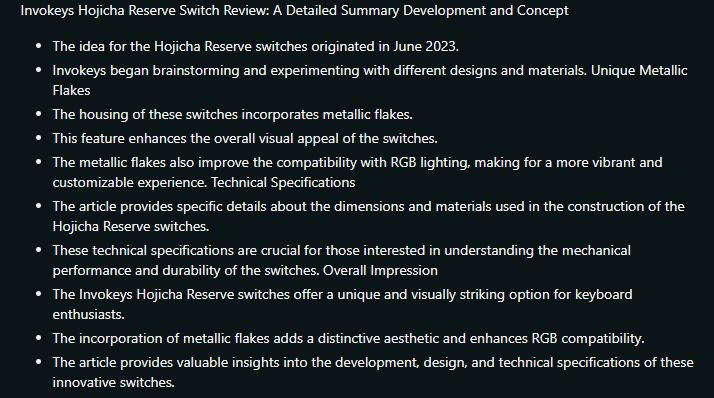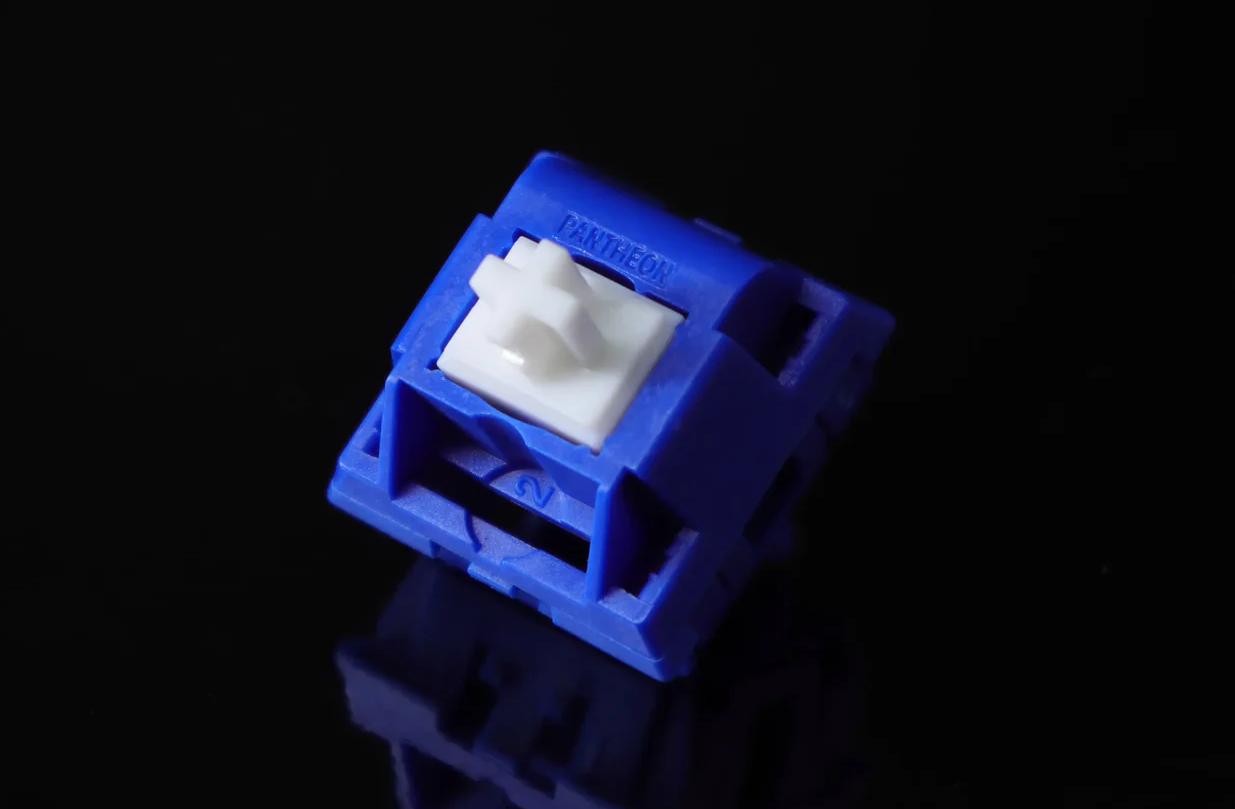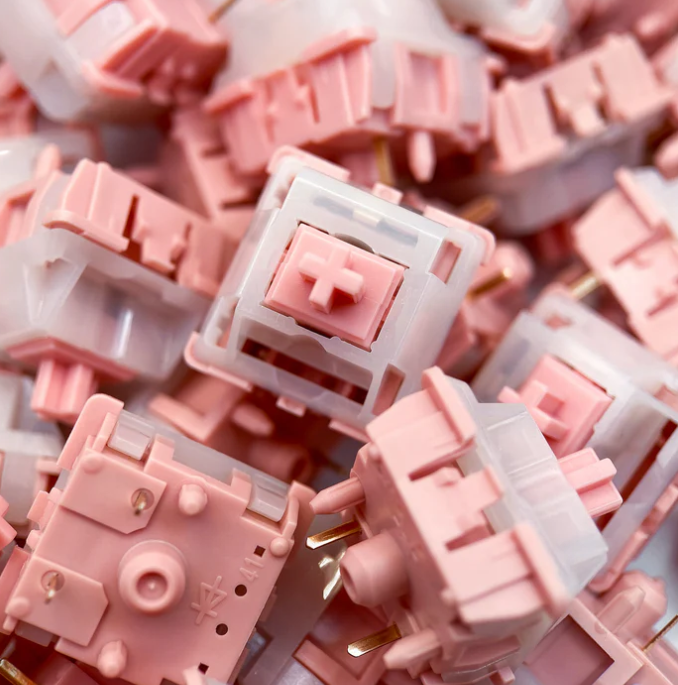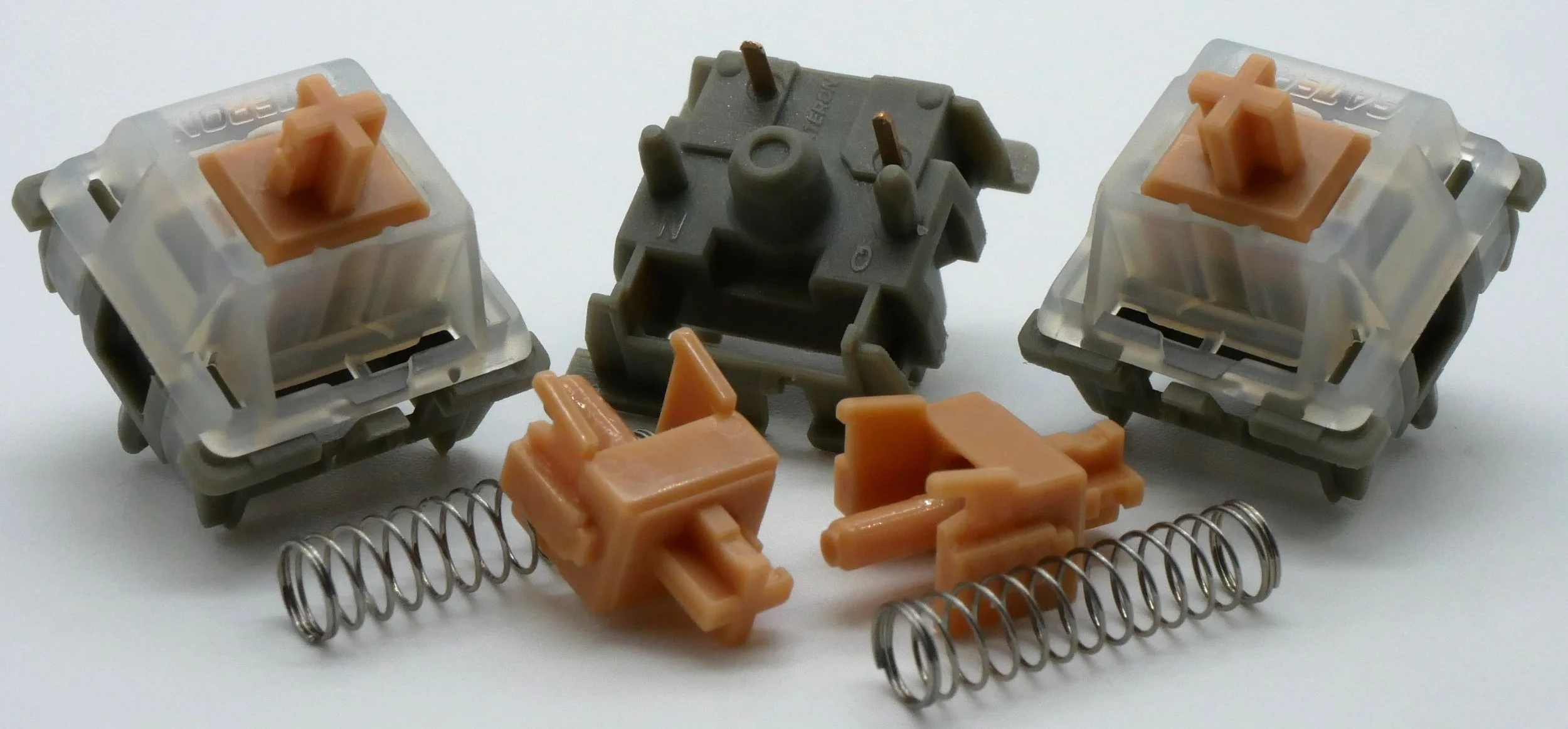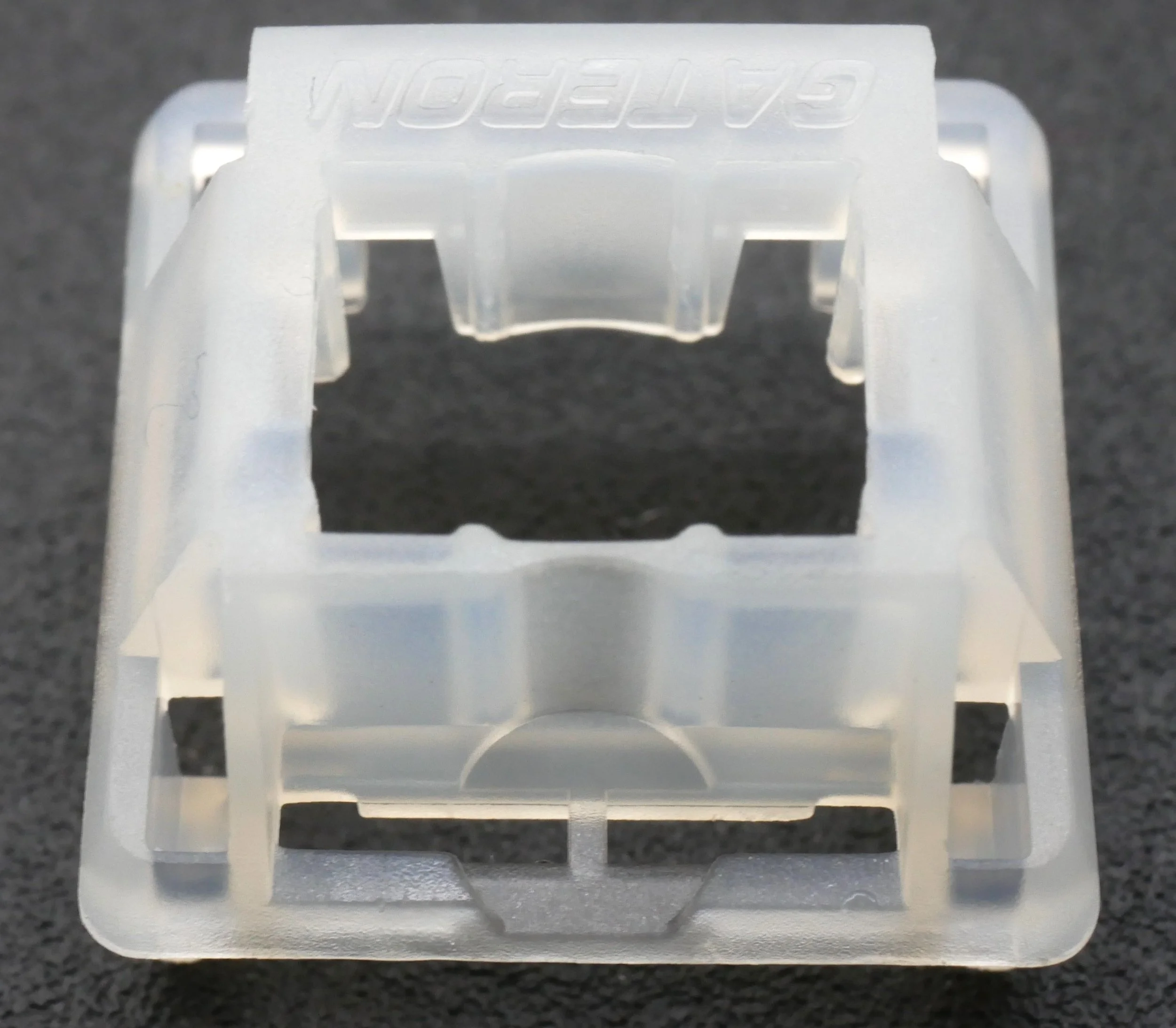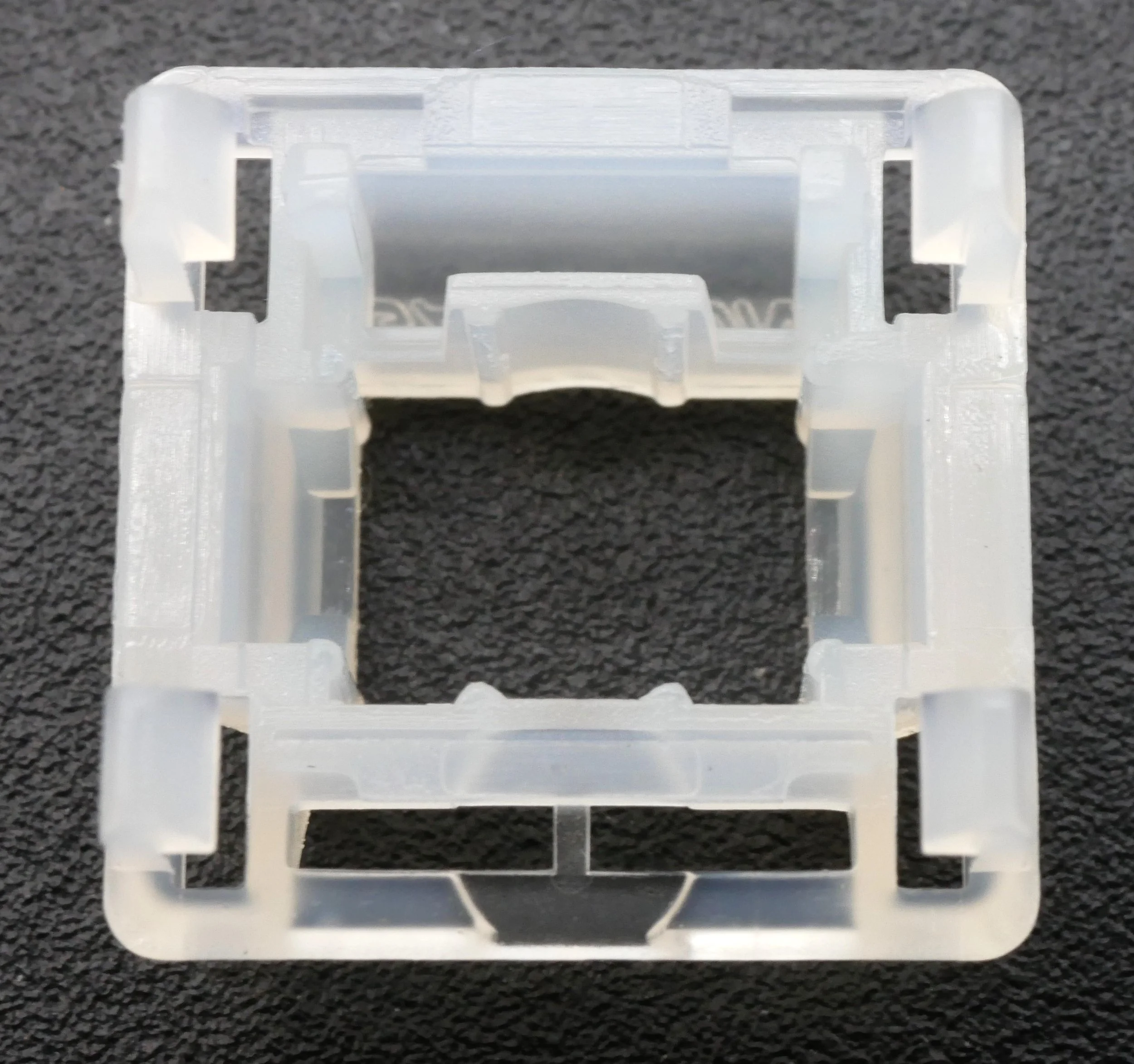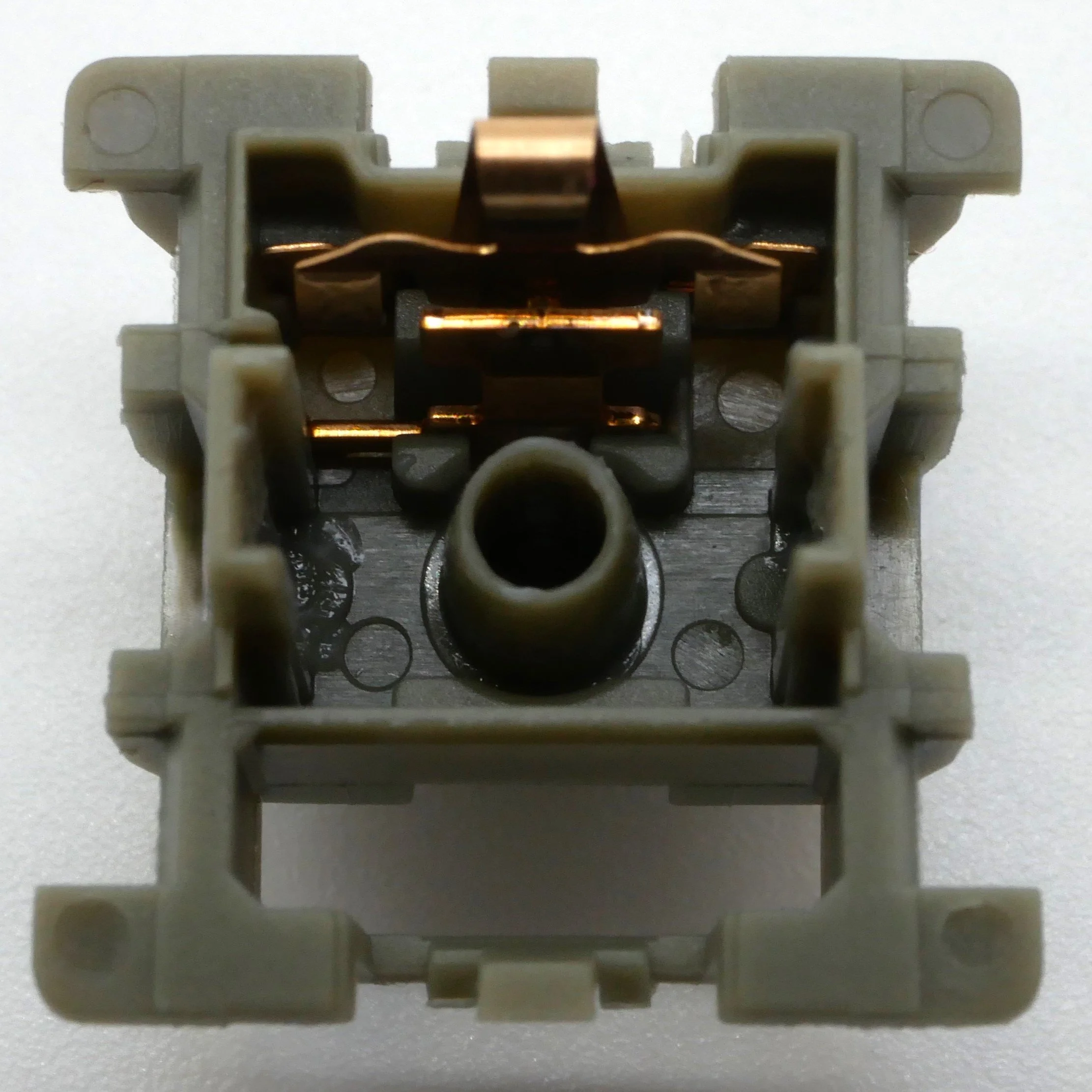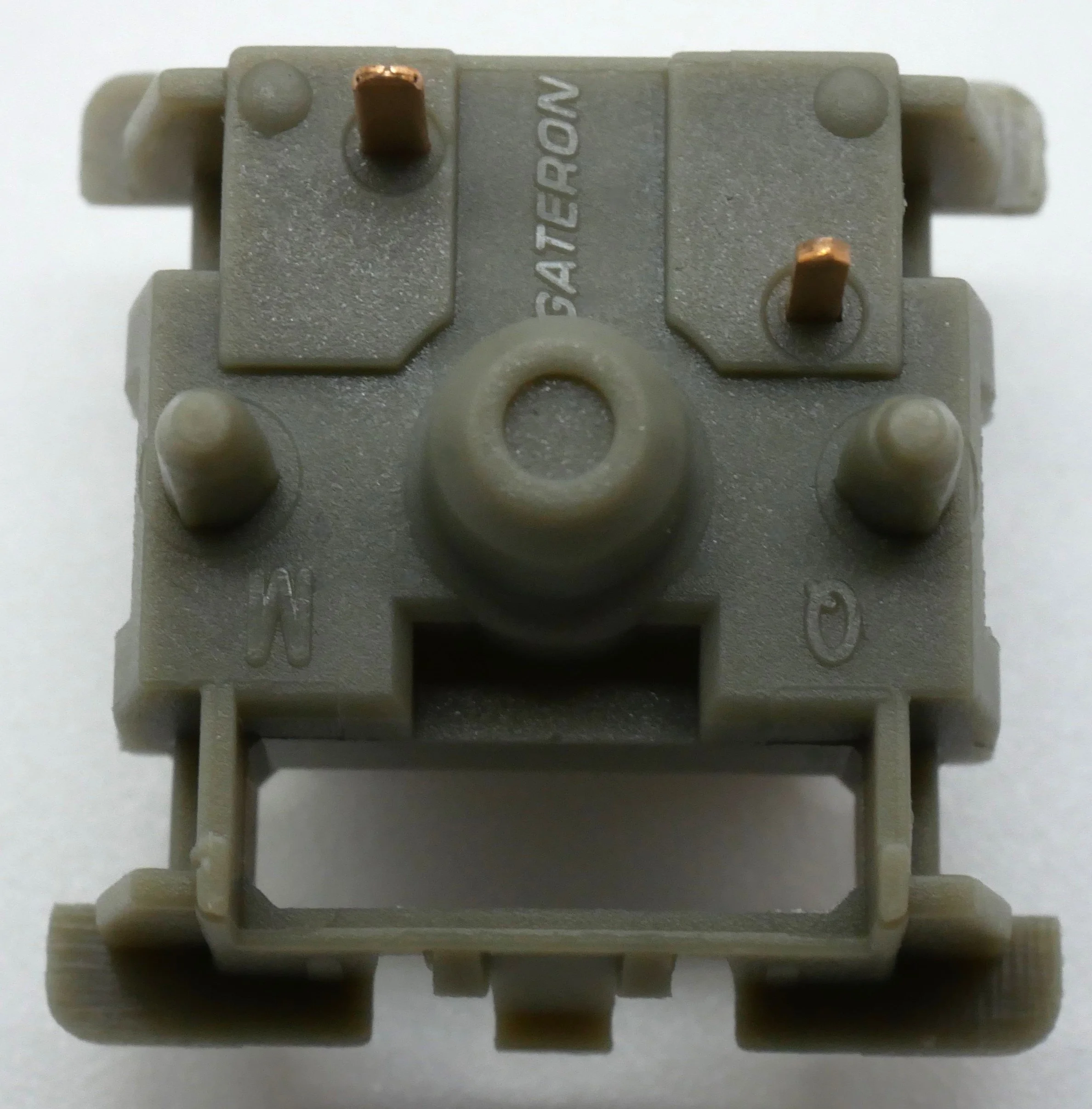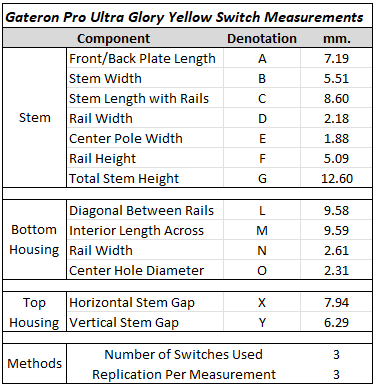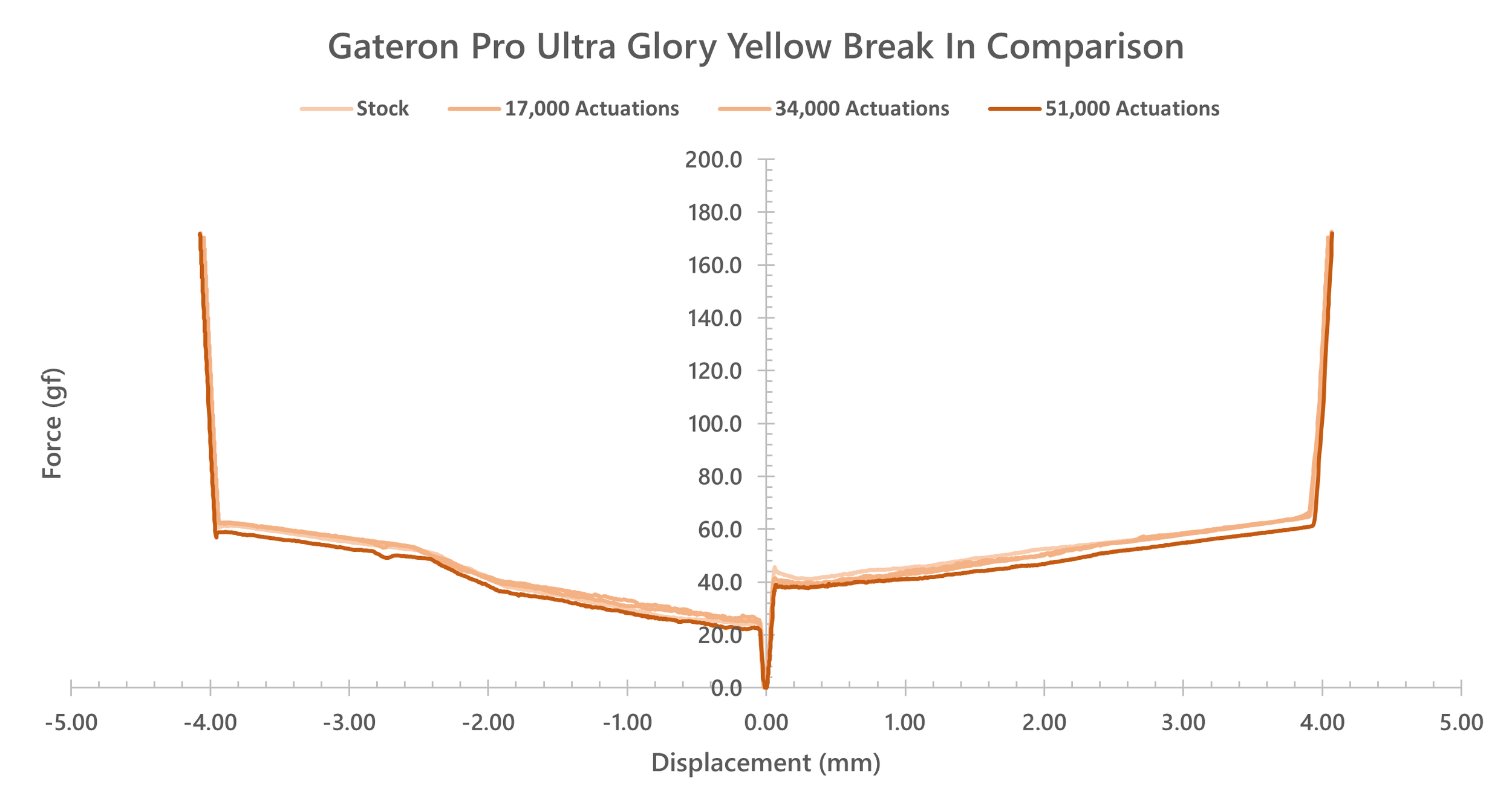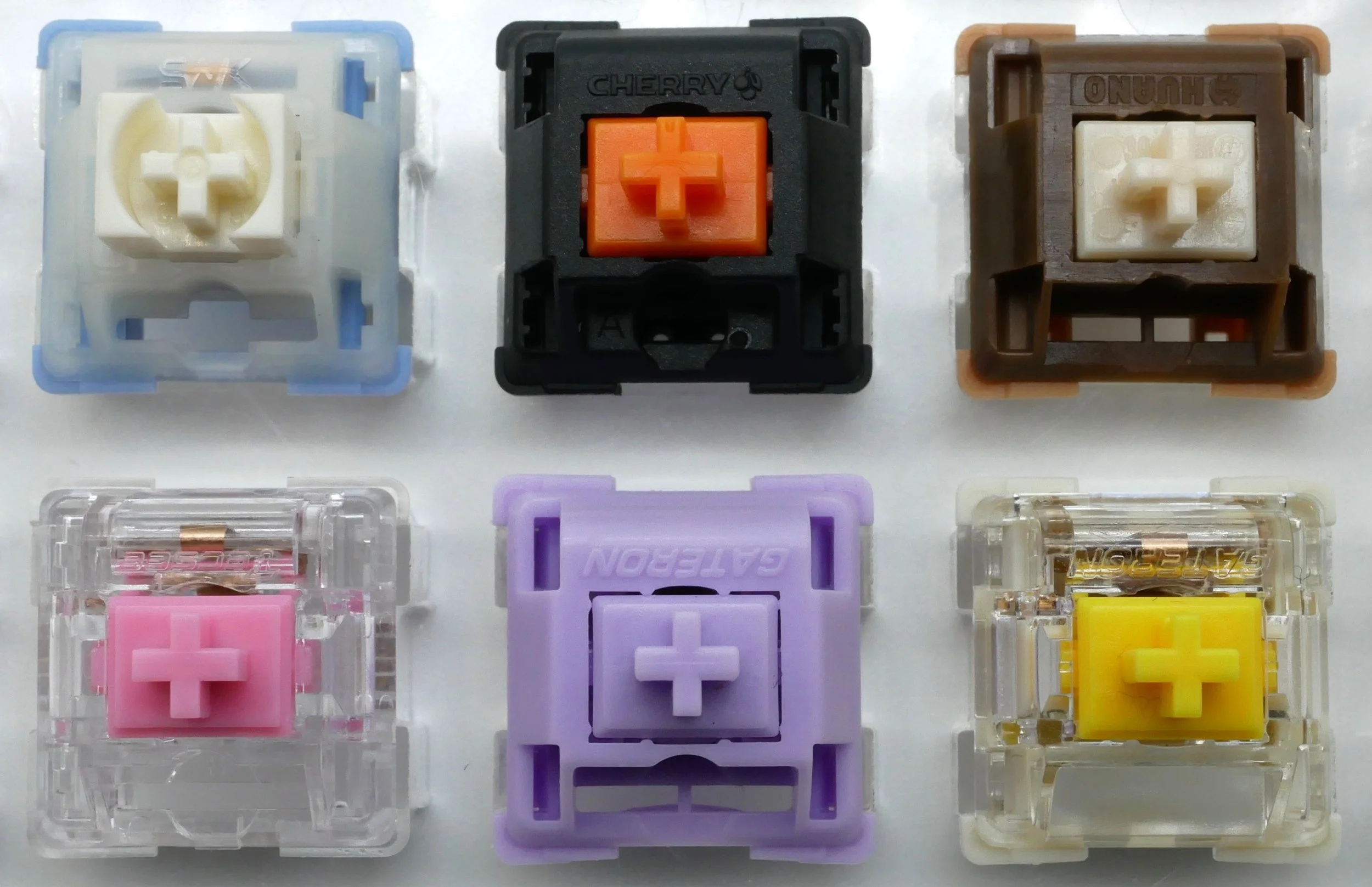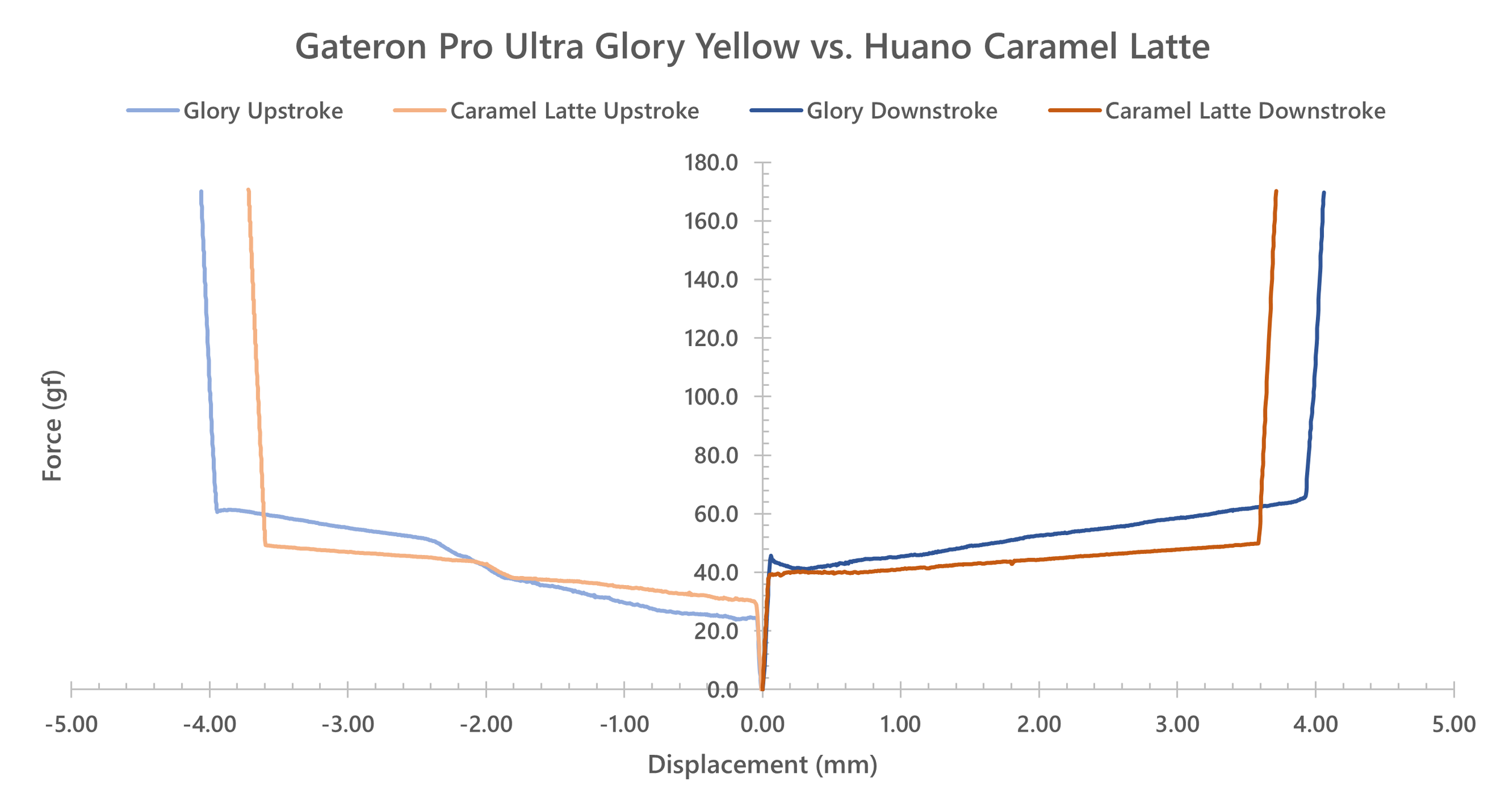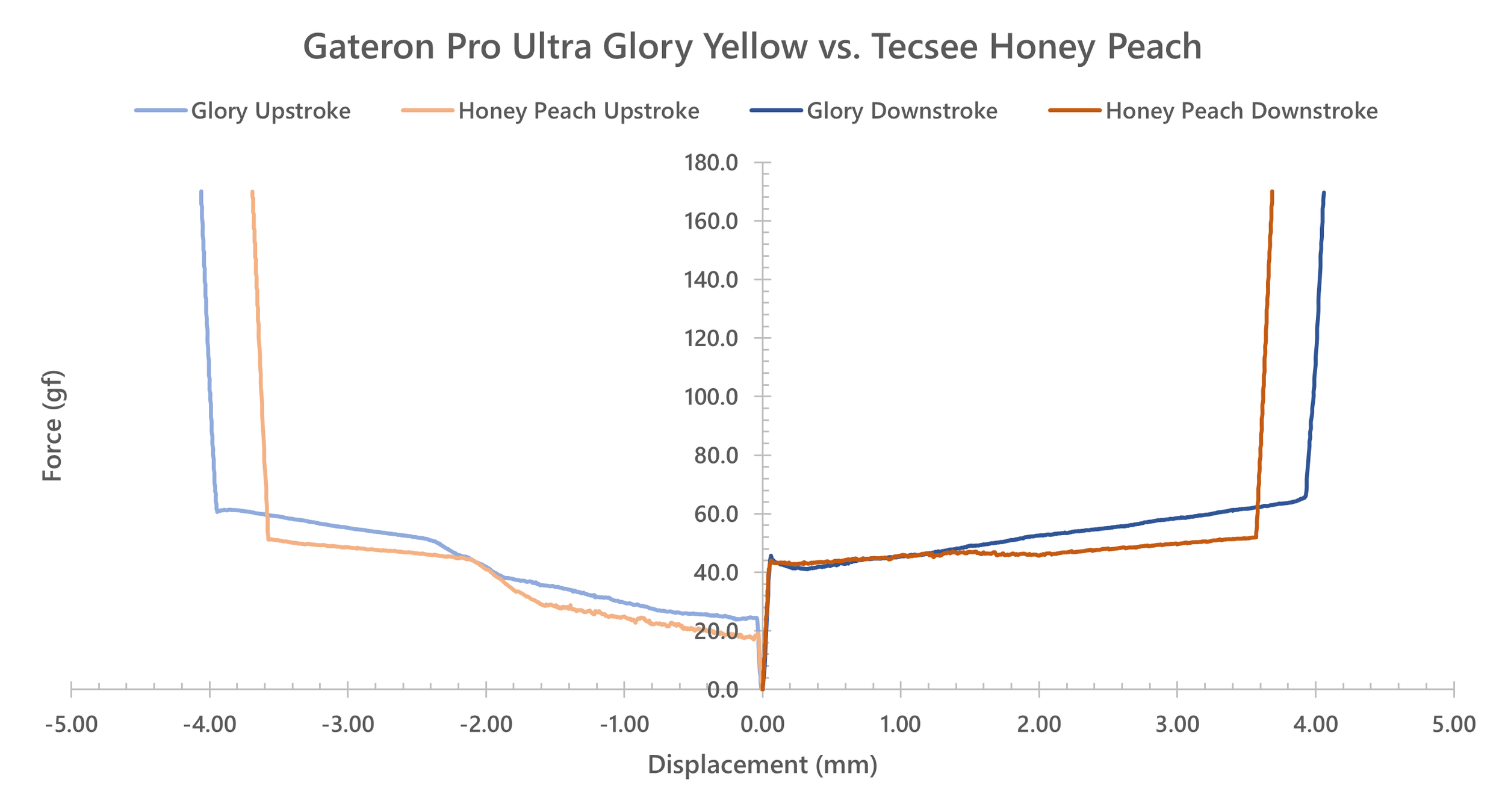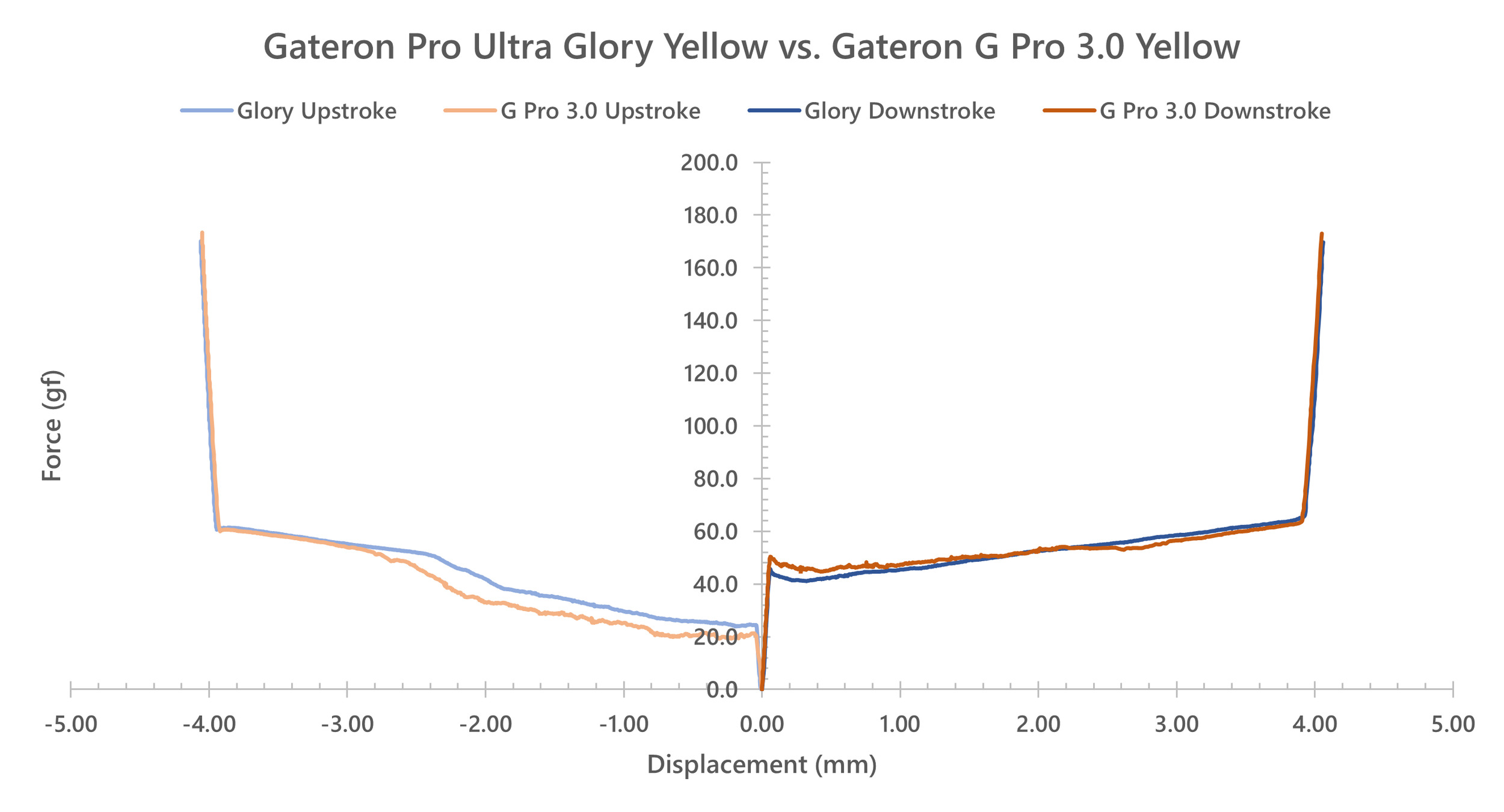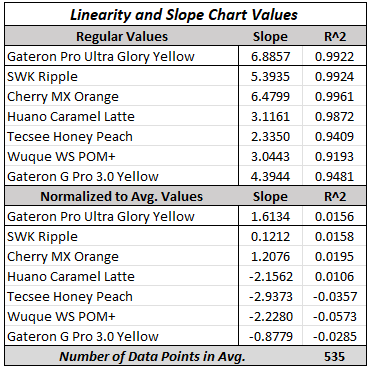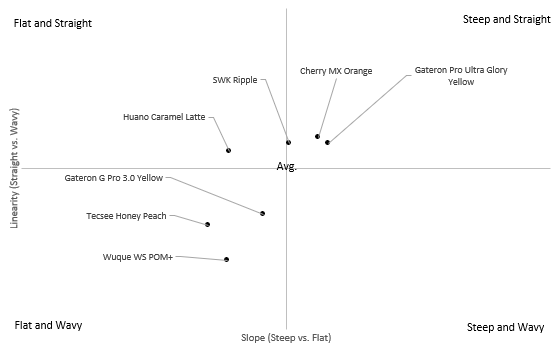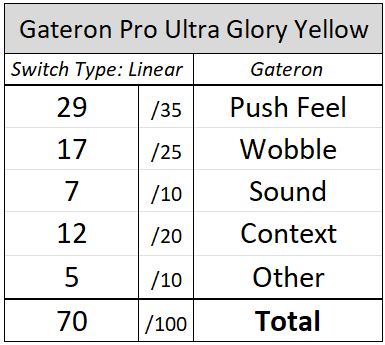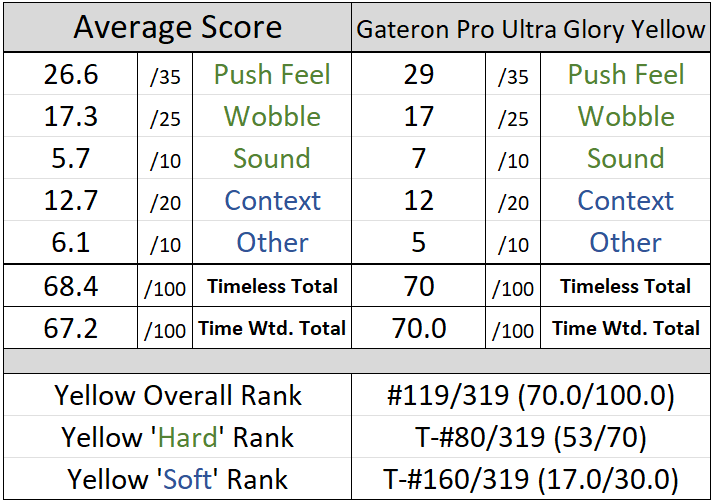Gateron Pro Ultra Glory Yellow Switch Review
While I do a whole slew of normal human things on any given weekend – laundry, cooking for the work week, going out to see movies, etc. – the weekends where I write and post full length articles tend to have some of the most memorable moments in them. They’re not memorable because of any sort of vague self-congratulatory feeling that comes about after finally getting to share that week’s magnum opus with the world, but rather it comes from the comments that get posted in response to my reviews on various social media platforms. On one hand, I got lots of genuinely kind and supportive words from users that encourages me to keep writing on the tough weeks. On the other hand, I seemingly get at least one person every weekend that complains about the length of the reviews in every which way possible. Now while I do genuinely appreciate the heartwarming comments from my supporters, I have to say that my real guilty pleasure is in the negative comments and especially so when the users dig in on their point. If poked hard enough, any old word-hating commenter will push back with insults claiming that I need an editor, that I have no life, am pedantic about worthless plastic, or really just any general name calling they can come up with. (To be entirely honest, they’re not really original thoughts most of the time.) My absolute favorite of these trolls, though, are the ones that threaten and then actually post a ChatGPT/AI summary of my article into my own comments. Completely watching the point whiz over their heads that they can actually only do this because of the work that I did put into my review and not in spite of it, often times these trolls post summaries even if they have virtually no coherent summaries in them whatsoever. All things considered, ChatGPT is not good at summarizing my content… or at least that is what I would have said before the Hojicha Reserve Switch Review last weekend. One hilarious commenter, who I am so thankful for in hindsight, posted this incredibly insightful summary of my review from ChatGPT and I have to say…
Figure 1: I've never felt better about the potential future AI take over than right now.
Without an absolute shred of irony, I can now officially say that AI actively recognizes my articles as “providing valuable insights” and that my work contains “technical specifications crucial for those interested in understanding the mechanical performance and durability of switches.” When AM comes to take over us all and enslave the Earth, I now know with confidence that I’ll be spared an eternity of peace instead.
Figure 2: I have no mouth and I must thock.
Switch Background
Speaking of name calling, I have to fess up a bit here and admit that my true intentions behind picking a switch for a full length review are sometimes a tiny bit shallow. Most of the time, I try and pick switches that are innovative and groundbreaking, have interesting performance properties, or at the extreme least intersect the history of modern mechanical keyboard switches at a junction I’ve not covered before in writing. After all, in order to be able to write a review about a switch that is several thousand words long, the switch has to at least have something redeemable to discuss. However, switches will rarely call out to me, begging to be reviewed for the dumbest of reasons – like having a generally funny sounding name. My full and honest truth about this review here is that I picked the Gateron Pro Ultra Glory Yellow switches purely because they sound like a comedic jumble of over the top descriptors in my head and I can’t keep the name straight in my head to save my absolute life. Is it Ultra Glory Pro? Glory Pro Yellows? Ultra Yellow Pros? Odds are, at least a couple of times in this review I will screw it up despite the fact that I actually had to write the proper name on a sticky note and stick it to my screen for the process of writing this review. I can’t say that I’ve ever had to engage in this kind of behavior when writing a switch review before, but the novelty of the experience does keep it a bit fun for me to write this week.
Since I’m clearly taking a fun-first approach to this review this weekend, I also think that this Background section should be a bit unique and quirky as well. While this would be an opportune place to discuss the history of the Gateron Pro Ultra Glory Yellow switches, they are unfortunately only 4-5 months old as of the time of writing this article and they’ve largely flown under the radar of the community at large as flocks of other Gateron premium and Hall Effect offerings have taken over. Without much direct, explicit history tied to the Pro Ultra Glory Yellows, the next best thing for me to do is to contextually slot them next to similar-ish switches in the massive framework of modern mechanical keyboard switches and describe how they stack up there. What better way to go about that than to group them together with other switches I’ve encountered over the years with memorable, puzzling, or unique names attached to them. In the vast world of mechanical keyboard switches out there, in my head the Gateron Pro Ultra Glory Yellow switches fit right alongside:
“This Switch Is Called”
Figure 3: 'This Switch Is Called' switch marketing photo from PantheonKeys' sales page.
The latest addition to the ‘funny name’ switch list in my head is that of the Keygeek-made “This Switch Is Called” switches. Designed and released by PantheonKeys in June of 2024, these linear switches are actually quite standout in their construction as they feature a combination of a “POK” top housing with a fiberglass-reinforced nylon bottom housing – something of which I don’t recall having ever seen in a switch before. While fiberglass-reinforced housings are only just now starting to be discussed as even remotely possible in the mechanical keyboard switch world, these switches almost certainly won’t help them reach mainstream discussion any time soon. The self referential meme of calling a switch the “This Switch Is Called” switch almost entirely destroys not only any easy ability to search for these switches online but also the sanity of anyone bold enough to review these switches. I have to give Pantheon some props here in being the first company to ever make me tap out of reviewing a switch just based on its name alone.
Follow The Wind Dog /Opgrey
Figure 4: Opgrey switch marketing photo from ThicThock's former sales page.
Long time fans of my reviews will likely have had a “lightbulb moment” upon reading the name of these switches again as the “Follow The Wind Dog” switches were first referenced by me back in my Opblack Switch Review posted on February 13th, 2021. All the way back then, Durock/JWK was still the premier manufacturer for the modern switch scene and 43Studios was among the most recognizable of eastern switch designers at the time. In early September of 2020, 43Studios announced the upcoming groupbuy of what would go on to be one of their most famous switches they ever ran in ‘Opblacks’. These milky topped, black stemmed linear switches were both explicitly stated as being and implicitly understood to be then modern renditions of the famous Cherry MX ‘Nixie’ switches, and they certainly sold out based on such expectations. With not everyone in the east not nearly as on board with this strong inspiration taken by 43Studios, shortly after the groupbuy for the Opblacks was completed, a new, grey stemmed tactile switch with a milky top housing and black bottom housing was posted by Revo titled as the “Follow The Wind Dog” switches. While this horribly translated name from Chinese to English very likely was trying to convey a slang term that was meant to describe “following the trend” in a mocking way, the funny translation stuck with western audiences and has been remembered as such by collectors for several years now. Officially, though, the “Follow The Wind Dog” switches are more commonly referred to by their proper, shorter name of “Opgreys”.
A Switch With No Good Name
Figure 5: 'A Switch With No Good Name' prototypes from my personal collection.
The second 43Studio switch entry to make this list is that of the “A Switch With No Good Name” switches that were first and only ever seen back in September of 2022. Teased via a ZFrontier post by the same name, these grey and dustproof yellow switches were among the first switch prototypes of switches to be made by Durock/JWK using dustproof stem molds and were reported as being more stable and featured an improved lubrication method using grease. In the remainder of this initial ZFrontier post, it was clear that “A Switch With No Good Name” switches were actually being referred to as such as they were a planned release by 43Studios that would have their name selected from a ‘choose the name’ style contest in the comments of this original post. However, for unknown reasons both the contest and release of the switches were very quickly and permanently shelved by 43Studios, leaving these few switch prototypes with arguably one of the most single unique switch names ever officially given out.
Leobog Pig Synapse
Figure 6: Leobog 'Pig Synapse' (bottom left) alongside other early Leobog/SOAI switches as discussed in an article on SwitchOddities' website.
Admittedly, the funniest names that I and other western switch collectors encounter on any given day almost certainly come about as a result of a Google translation of a Chinese name that was originally given to the switches. While I’m certain that the original runners of these switches did not name them with such odd and profound terms, sometimes the translations are just too funny to forget. The prime example of this is the Leobog “Pig Synapse” switches. First discovered all the way back in early 2022, these lightly tactile switches were among the first of Leobog/SOAI’s releases to hit the radars of western collectors and their name is almost solely what prevented us from ever forgetting them again. The name, itself, is either likely a combined failed translation of the switch runner’s name and the switch itself, or a direct mistranslation of “Boar Rush”, though even if I ever confirm either of these to be true they will forever be known as ‘Pig Synapses’ in my heart.
ALS (A Linear Switch)
Figure 7: ThicThock's 'ALS' switches in a marketing photo from Mekibo's sales page.
Debuted by the now defunct keyboard vendor ThicThock back in 2021, the ALS switches join this short list of funky names as a result of their unfortunate abbreviation that has a much stronger connotation elsewhere. (They’ll also have to be the representative switch for this category of odd names, as I’m not going to try and explain the Kailh Couple Series of switches in the Romeo and Juliets which were abbreviated online to the Kailh CP Romeo and CP Juliets…) Having absolutely nothing to do with famous baseball star Lou Gehrig nor any Ice Bucket Challenges from many years ago, the ‘ALS’ abbreviation simply stood for ‘A Linear Switch’ – something which is a bit fitting given their rather mundane specifications of a nylon-housing Durock/JWK made linear switch with an approximately 62gf. bottom out. In a way, it almost feels a bit fitting that a switch that is so commonplace that it could be confused for a half dozen other ones also has a name which could be confused with something else entirely.
Figure 8: Kailh's "Couple Series" Romeo and Juliet switch from iPopularStore's sales page.
KTT Purple Sauce
Figure 9: KTT Purple Sauce switch photo from my full length review.
Rounding off this list of oddly named switches before we formally induct the Gateron Pro Ultra Glory Yellows into this list is that of the previously reviewed KTT ‘Purple Sauce’ switches. These KTT clicky switches more than earned their spot on this list not because of the name ‘Purple Sauce’, but rather because of the fact that every single Chinese sales listing for these switches was somehow able to be translated into a wildly different English name. Whatever the slang phrase or colloquialism that was used to name these switches in Chinese was, it had English translations of ‘Purple Sauce Ring’, ‘Keiko Outer Setting’, and ‘Colleague Bettering Switch’ among a few others. Ultimately, when I sat down to reviews these switches in June of 2023, I selected and shortened the most coherent of these translations to be their name, officially dubbing these switches as KTT Purple Sauce switches as they are still referred to in the west to date. As of the time of writing this review, these switches are really the only ones that I’ve ever reviewed where I not only truly had no firm clue of what they were supposed to be called but also had absolutely no problem with willfully being incorrect about such.
Of all of the switches on my personal funny name list so far, the Gateron Pro Ultra Glory Yellow switches certainly earn their spot not because of being non-sensical or meta-level referential, but because of the fact that they are insanely tough to consistently call the correct thing. Somehow the combination of the words ‘Pro Ultra Glory Yellow’ just can not be consistently, coherently, nor seamlessly strung together in my head leading to an almost painful pause before saying the name out loud or writing it down. In spite of this brain-knotting naming scheme, the Pro Ultra Glory Yellow switches were debuted directly on Gateron’s various storefronts sometime in late April of 2024 sans any formal announcement or sales pitch. Available at a price point around $0.45 per switch, the Pro Ultra Glory Yellows were released alongside a lighter linear sibling in the Pro Ultra Glory Reds and are currently both available through a series of vendors including Gateron’s direct storefront, Divinikey, KPRepublic, and a few others. No marketing points on any of these pages directly clarifies the intent of the release of these switches nor if they are supposed to have features that are not represented elsewhere in Gateron’s catalogue, meaning that their premise and continued existence is tenuous, at best. As a result, it is uncertain how much longer Gateron will continue to offer manufacturing support for these switches.
Pro Ultra Glory Yellow Performance
Appearance
At the highest level, the Gateron Pro Ultra Glory Yellow switches come in a three part colorway with a milky translucent top housing, a greenish-grey colored bottom housing, and a tan-yellow colored stem. while these switches are definitely able to be recognized as ‘yellow’ compared to their release siblings in the Gateron Pro Ultra Glory Red switches, the stems of the Yellows are noticeably less vibrant and lemon-y than all of the other Gateron Yellow variants released over the years. In spite of this fact, though, these switches are still easily recognizable as being made by Gateron as a result of their nameplate on the top side of the switch and the anticounterfeit marking on the bottom of the switch as can be seen in the photographs below. Additionally, the fact that I believe the colorway for these switches is either unique or otherwise extremely rare in its appearance makes it unlikely that these would be mistaken for any other switches in passing. All other details worth noting about the Gateron Pro Ultra Glory Yellow switches occurs at the sub-part level and may be found in the paragraphs and photos below.
Figure 10: Gateron Pro Ultra Glory Yellow switches and its components.
Starting at the milky white nylon top housings of the Gateron Pro Ultra Glory Yellow switches, I feel confident in reporting that these are produced from the same molds that a large number of Gateron’s recent better-than-average yet run-of-the-mill offerings have also been made in. Looking back to other Gateron switches I’ve covered at length with fairly simplistic designs such as the Wuque WS POM+ and Gateron Deepping switches, I’m greeted with perfectly identical sets of features in those top housings that are also seen here in these switches. While these molds clearly aren’t used for switches which have more involved design features in them such as the Gateron Melodics or Everfree family of switches, I’d imagine a good number of modern Gateron switches bare these features. Externally, these commonalities include that of an inverted ‘GATERON’ nameplate and a thin rectangular LED slot that is both bifurcated and indented with a circle in the center of it for through-switch LED compatibility. Internally, the only features of note are that of Gateron’s classic mold markings in the upper left- and right-hand corners of the nameplate region in the form of single capital letters. For almost as long as I’ve been reviewing Gateron switches and looking for these features, these have been the locations and forms that I’ve found those markings in.
Figure 11: Gateron Pro Ultra Glory Yellow top housing exterior showing inverted 'GATERON' nameplate and bifurcated LED slot with centered circular indentation.
Figure 12: Gateron Pro Ultra Glory Yellow top housing interior showing two capital letter mold markings in the upper left- and right- hand corners in the nameplate region of the switch.
Moving next to the tan-yellow POM stems of the Gateron Pro Ultra Glory Yellow switches, I was initially caught off guard by the material choice for these components. While POM is the most common of thermoplastics used for stems in mechanical keyboard switches, the release sibling to these switches in the Gateron Pro Ultra Glory Red switches features a POK-material stem – something which I don’t recall Gateron having ever done before. It’s rare to see any pairing of switches like this vary on such a small technical detail without companies making a larger deal of it, and it’s the fact that this almost entirely flew under my radar that caught me off guard. Aside from this weird(?) design choice for this duo Pro Ultra Glory duo of switches, the Pro Ultra Glory Yellow stems are incredibly simplistic in their design and more similar to the ‘old style’ of stems than the newer, longer stem versions we’ve all become accustomed to. The slider rails aren’t tapered and the overall stem length is “short” at 12.60 mm. There’s mold ejector circles on the front plate of the stem. And on top of all of these features is a thin but generous, evenly distributed amount of factory lubing. All things considered, they’re truly as forgettable of a stem design as their name.
Figure 13: Gateron Pro Ultra Glory Yellow stems showing squared off slider rails, short center pole, and mold ejector circles on the front plate of the stem.
Arriving finally at the greenish-grey nylon bottom housings of the Gateron Pro Ultra Glory Yellow switches, these too feature a slew of design and features which have been previously noted in other modern Gateron offerings. Internally, these features include that of a medium-sized south side spring collar, centered, semi-circular dampening pads at the base of the slider rails, and traces amount of factory lubing that have worn off from the stem during use. Externally, the Pro Ultra Glory Yellow switches are 5-Pin/PCB mount with two upside down capital letter mold markings located just underneath them. As mentioned above, these housings also have the sideways embossed ‘GATERON’ anticounterfeit marking in basically identical fashion as to the previously referenced Wuque WS POM+ switches.
Figure 14: Gateron Pro Ultra Glory Yellow bottom housing interior showing medium sized spring collar, dampening pads at the base of the slider rails, and trace amounts of factory lubrication.
Figure 15: Gateron Pro Ultra Glory Yellow bottom housing exterior showing PCB mounting pins, double capital letter mold markings, and sideways 'GATERON' anticounterfeit marking.
Push Feel
All of the combined nuances of the push feeling in the Gateron Pro Ultra Glory Yellow switches totals up to something that does not check the boxes of ‘Pro’, ‘Ultra’, nor ‘Glorious’ adjectives in any discernable way. Even before physically testing out these switches in hand, the marketing points alone of being a 4.00 mm travel distance, 65 gf bottom out switch makes them a wholly “average” prospect on paper. In hand, the switches live up to those minimal expectations in delivering a very average feeling linear experience for a modern Gateron-made offering. The factory lubing that is present in these switches is visually thin and well dispersed as discussed above, though feels much more heavy in practice and lends the smoothness of these switches a bit of weight that makes them feel closer to hand lubed than thinly lubed by a machine. In a way, the heaviness in downstroke and upstroke of the Pro Ultra Glory Yellows reminds me a bit of the early days of Gateron’s improved factory lubing system in 2021, with switches that were lubed feeling significantly more heavily lubed and sluggish in their feeling than some of Gateron’s more recent, refined offerings in 2023 and 2024. All that being said, though, the switches are still smooth throughout their strokes and are consistently smooth across the batch of switches that I received. As for the housing collisions of the Pro Ultra Glory Yellows, they are a touch mismatched but overall subtle enough as to not detract from the switch’s overall feeling. The heavy touch of lube in the switches aids in the bottoming out of the Pro Ultra Glory Yellows feeling virtually unnoticeable and dampened whereas the topping out feels like a sort of light ‘peck’ in that there’s no degree of sharpness or really firm body to the topping out; It feels just like a subtle tap that lets you know that it’s there.
Figure 16: Force curve diagram for stock Gateron Pro Ultra Glory Yellow switches.
Looking at the force curve for the Gateron Pro Ultra Glory Yellow switches, I do feel inclined to say that some part of my brain is telling me that this seems steeper than normal for Gateron-made switches. While I’ve not yet done any retrospective studies on force curves grouped by manufacturer, I feel like a good number of the linear switches which I’ve processed for Gateron tend to have force curves that are flatter than this and don’t nearly have as much of an increase in force from start to finish of the downstroke. In my head, the steepness of this curve is almost more like that of Cherry-made switches, whose springs tend to produce significantly more steep increases in linear force than most other brands. Realistically, it’s not likely that this is not pointing towards any sort of super-secret design feature nor conspiracy surrounding the development of the Gateron Pro Ultra Glory Yellows. However, I feel inclined to share this weird hunch in the event that there is something more here…
Sound
The Gateorn Pro Ultra Glory Yellow switches are quite quiet linear switches that have an overall sound profile that largely matches the sparse, subtle notes that dominate the push feeling descriptions in the section above. The most apparent sound of the few features which stand out in these switches is that of the topping out that hits with a poppy, medium pitched, and flat sounding tone which is made much more apparent in juxtaposition with the otherwise silent, unnoticeable bottoming out sound. The only other real sonic feature which pops up in the Pro Ultra Glory Yellow switches is that of a subtle, small grain leathery scratch tone that acts as a backdrop to overall sound of the switches and is sometimes hard to pick up on when typing on them at faster actuation speeds. While this is a bit surprising to have present given just how heavily lubed these switches feel like they are, at the extreme least it is consistent across the batch of switches that I received and doesn’t seem to vary much between switches or at different typing speeds. Beyond these two features, though, the Gateron Pro Ultra Glory Yellows are effectively silent, and don’t seem to have much if anything that makes them try and stick out from the overall “average vibe” that they seem to be giving by all other performance metrics.
Wobble
The Gateron Pro Ultra Glory Yellow switches have a small amount of N/S and E/W direction stem wobble which is certainly a bit away from what they are technically capable of achieving yet still far from being likely to bother most users in the mechanical keyboard hobby space. These are consistent across the batch received as well, and feature no top housing give whatsoever.
Measurements
If you’re into this level of detail about your switches, you should know that I have a switch measurement sheet that logs all of this data, as well as many other cool features which can be found under the ‘Archive’ tab at the top of this page or by clicking on the card above. Known as the ‘Measurement Sheet’, this sheet typically gets updated weekly and aims to take physical measurements of various switch components to compare mold designs on a brand-by-brand basis as well as provide a rough frankenswitching estimation sheet for combining various stems and top housings.
Figure 18: Numerical details regarding the stock Gateron Pro Ultra Glory Yellow switch force curve diagram.
Have you ever wanted to be bombarded with more switch data than you’ve ever seen at any point in your life before? Consider checking out the ‘Force Curve Repository’ hosted on my GitHub that contains all force curves that I take both within and outside of these full-length reviews. In addition to having these graphs above, I have various other versions of the graphs, raw data, and my processed data all available for over 1000 different switches for you to use however you see fit. Check it out via the ‘Archive’ tab at the top of this page or by clicking any of the force curve cards above.
Break In
Break In Notes
17,000 Actuations
- At 17,000 actuations, the Gateron Pro Ultra Glory Yellow switches have minorly increased N/S and E/W direction stem travel as compared to their stock variants. While still not likely to bother most keyboard users at this point, it’s present enough to be noteworthy.
- The biggest change in the Pro Ultra Glory Yellow switches broken out to 17,000 actuations is the overall shift in their sound profile with respect to their topping out. As a result of what I can only assume to be lube migration in the switches, the topping out begins to sound a bit more ‘poppy’ and squishy and varies more with typing speeds at this degree of break in as compared to the stock switches.
34,000 Actuations
- At 34,000 actuations, the shift in broader sound profile of the Gateron Pro Ultra Glory Yellow switches continues to grow, also bringing in the bottoming out as well. Once broken out this far, the bottoming out of these switches no longer is fully silent and begins to take on a similar sort of squishy tone as was noted in the topping out at 17,000 actuations above. The same notes listed above for the topping out also apply here as well.
51,000 Actuations
- At 51,000 actuations, there is another noticeable increase in the stem wobble of the Gateron Pro Ultra Glory Yellow switches. Equal in magnitude in both N/S and E/W directions, these switches broken in this far are also noticeably more wobbly than the 17,000 or 34,000 actuation batch of switches.
- At this final stage of breaking in, the bottoming out of the Pro Ultra Glory Yellow switches also begins to take on a bit of a gummy, soft and squishy feeling to it to mimic that of the sound profile notes made above. While it’s not overwhelmingly bad, it is still present enough that I can differentiate these switches from stock ones when testing them in hand.
Figure 20: Comparative force curve diagram showing no substantial change in the force curves of the Gateron Pro Ultra Glory Yellow switches throughout the break in process.
Comparison Notes to Other Notable Linear Switches
Note – These are not aimed at being comprehensive comparisons between all factors of these switches as this would simply be too long for this writeup. These are little notes of interest I generated when comparing these switches to the Gateron Pro Ultra Glory Yellow switches side by side.
Figure 21: Switches for comparison. (L-R, Top-Bot: SWK Ripple, Cherry MX Orange, Huano Caramel Latte, Tecsee Honey Peach, Wuque WS POM+, and Gateron G Pro 3.0 Yellow)
SWK Ripple
- While both of these switches are somewhat similar in that they are both smooth, they could not be more different from each other in terms of their stock bottoming out feeling. Whereas the Gateron Pro Ultra Glory Yellow switches feel almost unnoticeably soft and dampened, the SWK Ripples have a stem pole-based bottom out that is prominent, sharp, and pointy.
- Unfortunately, the Pro Ultra Glory Yellow switches hardly stand a chance against the Ripples when it comes to stem wobble in both the N/S or E/W directions. The Ripple switches are significantly better on this metric.
- As can be seen in the comparative force curve for these two switches below, they do have a linear downstroke region that is quite similar to each other by the numbers. That being said, though, the Pro Ultra Glory Yellows do feel as if there is a touch more force to them likely as a result of their ‘thicker’ feeling factory lube than that of the SWK Ripples.
Cherry MX Orange
- In spite of the fact that these switches almost perfectly overlap each other as can be seen in their comparative force curve below, they hardly feel similar at all due to differences in factory lubing. In hand, the Cherry MX Oranges are much scratchier and inconsistent feeling than the stock Pro Ultra Glory Yellows.
- These two switches are fairly comparable in terms of their overall stem wobble, with perhaps the Pro Ultra Glory Yellows having a touch less N/S and E/W direction stem wobble than the Cherry MX Oranges.
- While these switches are similar in terms of their overall volume, the MX Oranges have a sound profile much more driven by scratch and subtle housing collisions than that of the topping out-forward sound profile of the Pro Ultra Glory Yellows.
Huano Caramel Latte
- Overall, the Huano Caramel Lattes feel and sound like a more clean, consistent, and well-tuned version of the Gateron Pro Ultra Glory Yellow switches. By comparison, the Caramel Lattes are a little more cleanly smooth feeling, with better balanced housing collisions, and an overall more premium feel to them.
- In terms of their stem wobble, the Huano Caramel Lattes edge out the Pro Ultra Glory Yellows by a touch, having a bit less N/S and E/W direction stem wobble.
- Despite what the comparative force curve below would suggest, these switches feel as if they have a pretty similar bottoming out weight when testing them side by side with one another.
Tecsee Honey Peach
- Of all of the switches on this comparison list, these are the two that have the biggest gap in difference between their overall sound profile. The Honey Peaches are loud, inconsistent, grating, and sharp as a result of their metal stem pole bottoming out and make the Pro Ultra Glory Yellow switches seem angelically quiet and demure by comparison.
- Surprisingly, these two switches do have a similar amount of N/S and E/W direction stem wobble when compared next to each other. The Gateron Pro Ultra Glory Yellow switches may be just a touch less wobbly than the Honey Peaches, though.
- In a similar fashion to the Huano Caramel Latte comparison above, the Tecsee Honey Peaches and Gateron Pro Ultra Glory Yellows feel as if they have almost identical total stem travel distances despite the Pro Ultra Glory Yellow stems moving for almost a half millimeter longer into their bottom housings.
Wuque WS POM+
- Unsurprisingly, of all of the switches on this comparison list, these are the two which feel and sound the most similar to one another. As discussed in the ‘Appearance’ section of this review above, these switches are almost identical in structure and appear to have been made fairly close to each other and with clear and consistent manufacturing intents present.
- For all the similarities that they do share, however, the Wuque WS POM+ switches are the only one of these two that have top housing wobble.
- Overall, the Wuque WS POM+ switches both feel and sound like they are more heavily lubed than that of the Gateron Pro Ultra Glory Yellow switches, though in all reality this could just be differences in how the lube from Gateron interfaces with nylon housings (Pro Ultra Glory Yellows) and POM housings (Wuque WS POM+).
Gateron G Pro 3.0 Yellow
- Despite both being made by Gateron and containing ‘Pro’ in their names, the Gateron Pro Ultra Glory Yellow switches have less stem wobble in them than the G Pro 3.0 Yellows.
- Unlike the Pro Ultra Glory Yellow switches, the factory lubing in the G Pro 3.0 Yellow switches feels much more delicately applied and gives the switch a much more subtly, thinly smooth feeling than the more heavy handed Pro Ultra Glory Yellows.
- Looking at their comparative force curve below, it’s clear that perhaps I was wrong in assuming earlier that Gateron linear switches were not nearly this steep in their force increase. Maybe I am, in fact, actually beginning to lose my mind.
Linearity
Figure 28: Absolute and relative Linearity and Slope values for each switch in this comparison section.
Figure 29: Qualitative comparison of the normalized Slope and Linearity for each switch in this comparison section.
If you are just now seeing this section for the first time and are a bit confused as to what I am talking about when discussing ‘Slope’ and ‘Linearity’, I highly suggest checking out my article titled ‘On Differences in Linear Switches’ where I explain what this section is for and how it came to be! For a bit of a shorter answer, know that this is part of my ongoing attempt to better quantify and articulate differences between linear switches which have historically not been captured in discussions about them.
Scores and Statistics
Note – These scores are not necessarily completely indicative of the nuanced review above. If you’ve skipped straight to this section, I can only recommend that you at least glance at the other sections above in order to get a stronger idea of my opinion about these switches.
Push Feel
The Gateron Pro Ultra Glory Yellow switches, despite their appearance, are very much another iteration of Gateron’s famous line of yellow switches and features full nylon housings and a roughly 65gf bottom out. With factory lube that feels a bit more heavy handed than other premium offerings from them, these switches are smooth but a bit sluggishly so. Housing collisions are a bit different from one another but fairly unique insofar that the bottoming out is unnoticeable in stock form while the topping out is a flat, peck like feeling that is consistent cross-batch and across typing speeds.
Wobble
There is very much an ‘average’ amount of N/S and E/W stem wobble in the Gateron Pro Ultra Glory Yellow switches that is not likely to bother many users. Unlike similarly constructed Wuque WS POM+ switches, these do not have any top housing wobble to them.
Sound
In their stock form, there’s hardly anything to detract from the Gateron Pro Ultra Glory Yellow switches. The topping out sound more or less mimics that of the push feeling notes above and the other sound that is really present in these switches is that of a subtle backdrop of small grain, very fine scratch that can be heard in the downstrokes of the Pro Ultra Glory Yellows.
Context
Priced around $0.45 per switch and available at a couple of different keyboard vendors, these switches are far from poorly priced for their performance nor unavailable. That being said, though, there’s hardly anything here that makes them stand out and really drive the broader community to both care about and seek out these switches for their boards.
Other
Normally, Gateron’s design intent is able to be seen in their final switches. In the Pro Ultra Glory Yellows, though, it’s hard to see anything substantial or unique that drove them to be produced in the first place.
Statistics
If you are looking at this statistics section and wondering what the heck happened since the last review, consider checking out my short article titled ‘A Scorecard Time Change’. Moving forward, switches are now ranked in this statistics table using a “time weighted total” as opposed to their day-of scoring as discussed in that article. If you’d also like to learn about what ‘hard’ versus ‘soft’ ranks refer to specifically, I’d encourage you to head on over to my GitHub linked in the table above or at the links in the top right hand of this website to check out my database of scorecards as well as the ‘Composite Score Sheet’ which has a full listing of the rankings for each and every switch I’ve ranked thus far.
Final Conclusions
Going into this review, these switches initially stood out to me for their relatively funky naming scheme and resultingly I expected a bit of something special out of their actual in hand performance. While Gateron has produced quite a few switches in the past few years that occupy a “sub-premium but better than most” space within the wider mechanical keyboard switch scene, seemingly every time they’ve invoked ‘extreme’ naming practices – ala “G Pro 3.0” – they tend to deliver something that makes the switches worthwhile of that name. The Gateron Pro Ultra Glory Yellows, though, just feel a bit like the status quo linear for Gateron. These certainly aren’t Gateron’s best showing of switches but they are also quite far from their worst too. The factory lubing on these switches is solid, producing a bit of a heavy handed but ultimately smooth push feeling that ends on either side of the stroke with subtle housing collisions that hardly distract from the overall feeling or sound of the switch. The rest of the performance metrics of the Pro Ultra Glory Yellows are also all respectable as well, though still painfully average on the grand scheme of things. Perhaps the pairing of the Pro Ultra Glory Yellows with their Red-stemmed release siblings was supposed to be a bigger thing? The side by side comparison of a POM- and POK-stemmed switch offered at the same price point and using identical production pathing could be a marketing stunt to try and really highlight and contrast the properties of these two stem materials, but there just isn’t any advertising to suggest that was what Gateron was going for. It’s entirely possible that they just bailed out of this sales pitch at the last minute and still decided to release the switches in a low-key fashion as they had already manufactured quite a few of them. Regardless of which, if any, of these conspiratorial claims are true, the Pro Ultra Glory Yellow switches are really only stand outs from the crowd for their hard to manage name and nothing else. While they’ll ultimately make a fun addition to your keyboard build if you like rattling off specifications and part names that confuse your non-keyboard friends you’re torturing with this information, these switches will only ever truly make for an overall average typing experience.
Sponsors/Affiliates
Mechbox UK
- A wonderful UK based operation which sells singles to switches that I’ve used above in my comparisons for collectors and the curious alike. Matt has gone out of his way to help me build out big parts of my collection, and buying something using this link supports him as well as my content!
KeebCats UK
- A switch peripheral company based out of the UK which sells everything switch adjacent you could ask for, they’ve been a huge help recently with my film and lube supply for personal builds, and they want to extend that help to you too. Use code ‘GOAT’ for 10% off your order when you check them out!
proto[Typist] Keyboards
- An all-things keyboard vendor based out of the UK, proto[Typist] is a regular stocker of everything from switches to the latest keyboard and keycap groupbuys. While I’ve bought things from the many times in the past, they also are a sponsor of my work and allow me to get some of the great switches I write about!
Divinikey
- Not only do they stock just about everything related to keyboards and switches, but they’re super friendly and ship out pretty quick too. Divinikey has been a huge help to me and my builds over the last year or two of doing reviews and they’ll definitely hook you up. Use code ‘GOAT’ for 5% off your order when you check them out!
ZealPC
- Do they really need any introduction? Zeal and crew kicked off the custom switch scene many years ago with their iconic Zealios switches and the story of switches today couldn’t be told without them. Use code ‘GOAT’ (or click the link above) for 5% off your order when you check them out!
MechMods UK
- A rising vendor based in the UK, Ryan and crew have been a pleasure to work with and have nearly everything you’d need to build your first or fourteenth keyboard. Go build your latest or greatest one right now with them by using code ‘GOAT’ at checkout for a 5% discount!
Dangkeebs
- A longtime supporter of the website and the collection, Dangkeebs has quite possibly the widest variety of switches of any vendor out there. Not only is their switch selection large, but it rotates and is constantly adding new stuff too. You’re going to need 5% off your order with my affiliate to save off the cost of all those switches!
SwitchOddities
- The brainchild of one my most adventurous proxies, SwitchOddities is a place where you can try out all the fancy, strange, and eastern-exclusive switches that I flex on my maildays with. Follow my affiliate code and use code ‘GOAT’ at checkout to save 5% on some of the most interesting switches you’ll ever try!
Cannonkeys
- Does anybody not know of Cannonkeys at this point? One of the largest vendors in North America with keyboards, switches, keycaps, and literally everything you could ever want for a keyboard always in stock and with an incredibly dedicated and loving crew. Follow my affiliate link above in their name to support both them and I when you buy yourself some switches!
Kinetic Labs
- One of the most well-rounded keyboard vendors out there, Christian and crew have been supporters of all my switch and switch-adjacent needs for some years now. I’m honored to have them as an affiliate and think you should check them out using my affiliate link above to support both them and I when you check out their awesome products!
Keebhut
- Want to try out some switch brands that fly under most vendor’s radars? Keebhut is always seeking out that next latest and greatest and has been super helpful in hooking me up with new brands over the past year. They are all about sharing that love as well, and want to give you 5% off your next order with them when you use code ‘GOAT’ at checkout!
Kailh
- No, you’re not mistaken – this is actually that Kailh that manufactures switches. As one of the longest running manufacturers in the hobby, they have a massive variety of switches available over on their website at any point in time. I’m lucky to be affiliated with them now, and so consider using my affiliate link above when ordering some Kailh switches to support me!
Further Reading
Gateron’s Pro Ultra Glory Yellow Sales Page
Divinikey’s Gateron Pro Ultra Glory Yellow Sales Page
KPRepublic’s Gateron Pro Ultra Glory Yellow Sales Page
Divinikey’s Gateron Pro Ultra Glory Yellow Sound Test
